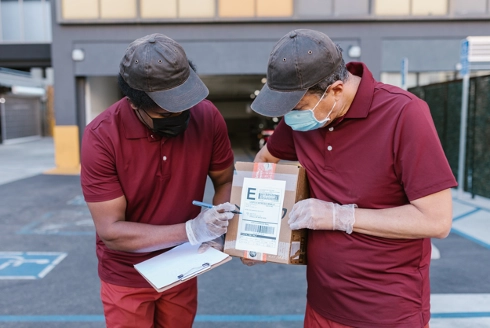.webp)
Barcode label technology has gained widespread adoption in the shipping world due to its almost flawless reliability. In fact, the read rates can exceed 99.9%.
But there's a catch- Your package label and shipping label barcode should be in top-notch condition.
Labeling and barcoding are the most crucial jobs right after the toil of cherry-picking and packing your merchandise. A minor mishap here is enough to negate previous efforts and spiral into costly impacts, such as wastage of resources, unhappy customers, and reduced ROI.
This article dives into the effects of poor labels, how to pinpoint one, and some of the best-case scenarios.
Understanding the Impact of Poor Labeling and Barcoding on ROI
Imagine a shipping company has processed 332 pieces, and 61 (18.37%) return "no-reads." Your ROI can suffer a massive blow due to:
- Product recalls: Printer errors, wrong data, and related issues often lead to recalls, which can tax the entire supply chain.
- Supply chain inefficiencies: Today's supply chain is a complex web of moving parts. Poor labeling can further complicate the operations, increasing labor costs and shipping delays.
- Materials costs: Correcting labels may need replacement of packaging materials on top of time and labor wastage.
- Reduced customer retention: The effects of damaged labels and barcodes can also damage your brand reputation, leading to customers shying away.
- Hefty fines: If you're in a regulated sector such as pharmaceuticals, the regulatory authorities may slap you with penalties due to mislabeling packages.
How to Recognize a Bad Shipping Label
Robust labels and barcodes make tracking packages a breeze. On the contrary, poor shipping labels lead to reading or scanning information difficulties. Understanding the difference can help you optimize your shipping strategy. Let's look into some signs of a poor shipping label and how to solve each:
1. Poorly Placed Shipping Label
Poor shipping label placement is the most notorious cause of no-reads in the packaging and shipping industry. Suppose you wrap a 1D barcode label around a small packet. The shipping team's camera system may fail to pick up the barcode due to the unfocused location of data.
Poor Label Placement Solutions
A standard operating procedure (SOP) can help eliminate or reduce this issue. The SOP should include pictograms demonstrating how employees should place the correct barcode and shipping label on a particular parcel.
2. Poorly Positioned Shipping Label Barcode
Poorly placed barcodes often arise from several culprits, including:
- Inappropriate distance between the barcode label and scanner: The scanner may fail to focus if it's too far or close to the barcode.
- Poor angle: Light can bounce from the barcode back to the scanner if they're perpendicular to each other. This reflection's blinding effect can reduce or prevent the signal's readability.
- Incompatible orientation of barcode: For instance, laser scanners need the laser line to be perpendicular to the barcode's bars.
Poorly Positioned Barcodes Solutions
Top-in-class shipping services and companies employ innovative solutions to solve this problem. Here are just some of them:
- Scanners with built-in autofocus: These devices help handle barcodes at different orientations, angles, and distances.
- Right-angled mirrors: These redirect the barcode's light to the reader, so long as the latter can scan flipped images.
- Barcode imagers: Unlike shipping barcode scanners, barcode imagers employ cameras instead of reflective laser signals to capture barcodes. That translates to significantly reduced interference from the laser's reflection. Furthermore, they can read barcode labels at a wide range of orientations.
3. Damaged Barcodes
Mechanical damage, such as tears and scratches in the shipping label, haunts packages on their way to final customers. Harsh conditions also contribute to damaged shipping label barcodes, including extreme temperatures, organic solvents, chemicals, and humidity. The result is faded or smudged barcodes, leading to "no-reads."
Damaged Barcode Solutions
- Choose the correct shipping label: The shipping label should stay on the package throughout the journey without getting damaged.
- Use robust printouts such as thermal-transfer printers: These printers protect labels against harsh conditions, preventing fading and smudging.
- Laminating labels: This trick helps keep both mechanical damages and harsh conditions at bay.
- Symbol reconstruction technology: Some scanners employ a technology that can reconstruct initial barcodes from the remaining scan lines.
4. Insufficient Contrast
No-reads may also happen if a scanner fails to tell the difference between a label's dark and light features due to its material. For instance, printing barcodes on metals might need to provide more contrast like thermoplastic film labels. Uneven bars and surfaces are another cause of insufficient contrast.
Insufficient Contrast Solutions
- Adjust printer settings: Reset it to ensure uniform ink distribution across the entire surface or label.
- Boost the barcode's brightness: Are you barcoding on uneven or noisy surfaces? Increase your barcode's brightness.
- Adjust scanner lighting: Such scanners can use diffused lighting if the surface is flat and glossy. For engraved barcodes, the scanner will use dark-field technology.
5. Quiet Zone Infractions
A quiet zone is that blank region surrounding the barcode. It allows the scanner to verify the barcode's boundaries and return correct readings.
This zone's size requirements may change based on your barcode's type. For 1D barcodes, it should measure 10 times the smallest bar's width on each side. For 2D barcodes, the size should be 10% of the label's width or height (whichever is smallest).
Quiet Zone Infractions Solutions
- Adjust settings: You can reset the quiet zone size as high as necessary past the minimum required dimension for proper reading.
- Repair or replace smudging printers: This prevents your printer from bleeding into the quiet zone, ensuring the region stays blank.
- Thermal-transfer printer: It reduces the potential smearing of ink into the quiet zone or damage.
6. Inconsistent Printout
Low toners and ink levels are the main culprits behind fluctuating ink intensity, causing inconsistent printing of barcodes when you print shipping labels. The printer may also stop completely, jam, and form air bubbles in the cartridge.
Inconsistent Printout Solutions
- Thermal-transfer printer: This thermal label printer can iron out many problems related to inconsistencies in printing shipping labels, thanks to wax and resin ribbons used to create thermal labels.
- Check printer's settings: When printing labels, reset the space between the print head and label to an appropriate distance. Also, ensure the nozzles' and print-heads integrity are okay.
Do you use laser printers to print labels? Reset "Media/Paper type" to "Label" to increase the ink's stickiness.
Ideal Shipping Labels: Best Case

Now that you know what a bad shipping label or barcode looks like, what shows an ideal labeling?
1. Clear Shipping Labels
Ideally, the shipping labels should be on one surface of your parcels and be free from obstructions, creases, wrinkles, or folds. A clear, flat, and smooth label ensures unobstructed reading of the barcode and other details.
2. Clear Barcodes
The barcode is a critical component of your shipping labels. When printing your barcode labels, ensure your label printers can produce high print quality for shipping labels with clear sharp lines (no smudging).
The Control Bars (the horizontal black lines above and below the barcode) should be continuously black without any white lines or breaks.
3. Strategic Placement
Placement is also important when creating shipping and barcode labels for your package. Ideally, your label should be in the middle of one of your package's surfaces for easy scanning.
You might ask, "What if the shipping labels go onto another surface." That's still okay so long as the barcode and address remain on the same side.
4. Address Plus Barcode -The Ideal Pairing
Ideally, the barcode and address should be on the same surface. In case of an issue with the barcode, a readable address will act as a backup.
Acceptable Labels: Special Cases
What if it's impossible to place both the barcode and address on the same surface? You should prioritize the barcode in such a case. Once again, ensure the barcode is:
- Clear: It should be as flat as possible and free of creases or obstructions caused by packaging.
- Completely on one surface of the package
Unacceptable Packages
"No-reads" often arise from two issues:
- Bad shipping label placement: Folding the printed label over the package's edges can give the scanner a hard time reading your barcode.
- Damaged barcode: Partially faded or physically damaged barcodes are prone to scanning errors and increase the likelihood of human error in delivery.
What Can You Do?

Proper shipping labels and barcodes enhance frictionless and efficient deliveries. Adhering to ideal labeling practices and understanding acceptable variations significantly reduces the risk of undelivered packages.
Remember, a well-labeled parcel is a testament to your attention to detail and a guarantee of customer satisfaction. So take the time to label each package with care and precision, and watch as your shipping process becomes seamless.
At FirstMile, our camera system comprises a SICK reader module with a SICK 6-sided scan camera (ICR890) configuration per lane. For a valid barcode, it reads each parcel's top, sides, and bottom. Two VMS scanners are placed just before each reader to size each package.
When shipping outbound packages, we care for our client's brands and ensure proper shipping labels, barcodes, and barcode placement for every package that leaves our doors. That's why our shipping label read-rate percentage is in the high 90s compared to the industry standard percentage in the low 90s. Other shipping partners don't pay attention, have bad barcoding practices, and simply don't value the partnership.
Why not regain control of your shipping costs with an all-in-one solution today? Request a quote for a customized solution.
1.svg)

.png)
.png)
.png)
.jpg)
.png)
.png)
.png)





.webp)
.webp)

.webp)
.png)

.png)
.webp)
.jpg)
.jpg)